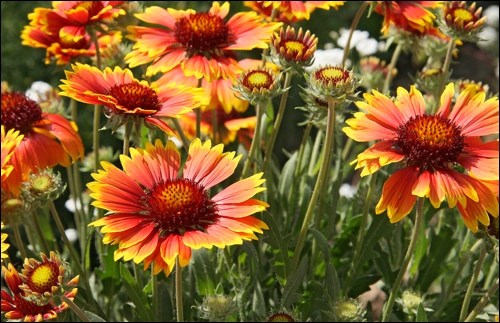While it’s too early to say we’re facing a drought in parts of the prairies, droughts are a regular occurrence in this region and sooner rather than later, we’ll be facing long stretches of low precipitation. So consider drought-proofing your garden by adopting some of the following suggestions.
Amend the soil with organic matter (e.g. compost or manure), especially if it’s sandy, to help retain water as well as to enrich the soil with essential nutrients. Make sure the organic matter has been composted sufficiently to kill weed seeds and diseases.
Cover bare soil with 10 to 15 centimetres organic mulch. Mulch not only reduces surface evaporation, it keeps the soil cool (reduces plant stress) and smoothers weed seedlings. Organic mulch breaks down and you will need to top dress your beds every two or three years. For transplants in the vegetable garden, consider using black (or red for tomatoes) plastic mulch to really reduce water loss and control weeds.
Use drip irrigation (e.g. weeping hoses) to irrigate your flower, shrub and vegetable beds (place under mulch layer). Water is applied right where it’s needed with little evaporation. Water early in the day so when it’s hot and dry, plants can draw up the water they need to stay hydrated and to cool themselves through evapo-transpiration.
Infrequent deep irrigation (e.g. apply three centimetres water once per week) encourages deep root formation allowing plants to reach water at depth; conversely shallow-rooted plants rely on surface moisture and are more likely to become stressed as soon as the soil starts to dry and soil temperature rises.
Keep your weeds under control. Weeds not only detract from the beauty of your garden, they also suck up water, steal nutrients and crowd out your ornamental plants. Also control pests and diseases as these put additional stress on your plants making them less able to respond to drought.
Finally, choose naturally drought-tolerant plants. Many of our native prairie plants are drought tolerant and make excellent ornamentals. Look for plants with deep roots, succulent leaves or hairy, silvery leaves. One strategy some plants use to survive drought is avoidance – they grow only in early spring or late fall and are dormant during the hottest and driest part of the year. For non-native plants, look for ones from other dry regions like the Mediterranean or northern interior Asia.
The following is a partial list of native (N) and introduced (I) drought tolerant plants.
Trees: Amur maple (I), bur oak (N), chokecherry (N), green ash (N), Manitoba maple (N), Russian olive (I), Scots pine (I), lodgepole pine (N), Colorado spruce (I), subalpine fir (I) and Siberian larch (I).
Shrubs and vines: caragana (I), dogwood (N), hawthorn (N), honeysuckle (I), juniper (N), lilac (I), mugo pine (I), prairie rose (N), potentilla (I), saskatoon berry (N), sea-buckthorn (I), silver and Canada buffaloberries (N), Virginia creeper (I) and wolf willow (N).
Perennials: artemesia (N), beebalm (aka monarda, N), black-eyed-Susan (aka rudbeckia, N), delphinium (I), dianthus (I), echinacea (I, N), gaillardia (N), iris (I, N), lamb’s ears (I), liatris (aka purple gayfeather, N), lily (I), sedum (I), statice (I), yarrow (N) and thrift (I).
Grasses: little bluestem (N), big bluestem (N), blue oatgrass (I), blue and sheep’s fescues (N) and Karl Foerster feather reed grass (I)
Annuals: cosmos (I), marigold (I), rose campion (I), zinnia (I) and annual statice (I)
Herbs: thyme (I), rosemary (I), oregano (I) and sage (I).
Announcements
In celebration of National Gardening Day, there will be a guided walking tour of Patterson Garden Arboretum (Saskatoon) Friday, June 19 beginning at 1 p.m. See Patterson Arboretum website for details: http://patterson-arboretum.usask.ca/events/tours.php
GardenLine is open for the season to solve your garden problems: 306-966-5865; gardenline@usask.ca
— This column is provided courtesy of the Saskatchewan Perennial Society (www.saskperennial.ca; hortscene@yahoo.com). Check out our Bulletin Board or Calendar for upcoming garden information sessions: Peony Show (June 26 & 27, Regina), Labour-and-Learn (June 27, 30), Open House & Guided Walking Tour at the Forestry Farm House (June 28).



